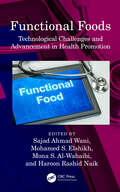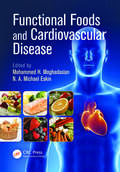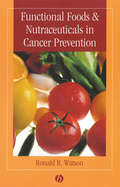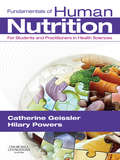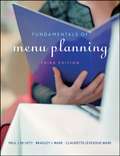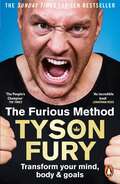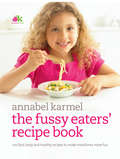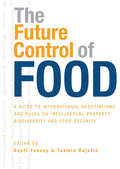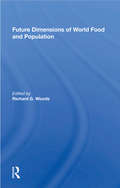- Table View
- List View
Functional Foods: Technological Challenges and Advancement in Health Promotion
by Sajad Ahmad Wani, Mohamed S. Elshikh, Mona S. Al-Wahaibi, and Haroon Rashid NaikIt is reported Functional foods are highly nutritious and associated with a number of powerful health benefits. They may protect against disease, prevent nutrient deficiencies, and promote proper growth and development. Functional Foods: Technological Challenges and Advancement in Health Promotion presents information related to bioactive compounds present in the functional foods, derived from fruits and vegetables, cereals and pulses, dairy and meat, herbs and spices and other foods. It describes novel techniques and methodologies used in the extraction, isolation, encapsulation, identification and characterization of bioactive compounds. Key Features: Covers the most recent research related to the bioactive compounds present in the functional foods Presents the latest information on extraction, isolation, encapsulation, identification and characterization Discusses formulation challenges with an emphasis on stability and safety evaluations of functional foods Finally, it includes substantial and scientific research and innovation for new product development with health benefits. This book will serve as a valuable resource for researchers, academicians, and students interested in many aspects of functional foods.
Functional Foods: Technological Challenges and Advancement in Health Promotion
by Sajad Ahmad Wani Mohamed S. Elshikh Mona S. Al-Wahaibi Haroon Rashid NaikIt is reported Functional foods are highly nutritious and associated with a number of powerful health benefits. They may protect against disease, prevent nutrient deficiencies, and promote proper growth and development. Functional Foods: Technological Challenges and Advancement in Health Promotion presents information related to bioactive compounds present in the functional foods, derived from fruits and vegetables, cereals and pulses, dairy and meat, herbs and spices and other foods. It describes novel techniques and methodologies used in the extraction, isolation, encapsulation, identification and characterization of bioactive compounds. Key Features: Covers the most recent research related to the bioactive compounds present in the functional foods Presents the latest information on extraction, isolation, encapsulation, identification and characterization Discusses formulation challenges with an emphasis on stability and safety evaluations of functional foods Finally, it includes substantial and scientific research and innovation for new product development with health benefits. This book will serve as a valuable resource for researchers, academicians, and students interested in many aspects of functional foods.
The Functional Foods: Nutrient and Health Benefits (Innovations in Plant Science for Better Health: From Soil to Fork)
The consumption of functional foods is growing in the health and wellness communities because of their range of potent nutrients and health advantages, such as the ability to shield against illnesses, stop vitamin deficiencies, and encourage healthy growth and development.This new volume discusses the nutritional and health benefits of functional foods. The volume first looks at the functional activities of plants and their derivatives, discussing microgreens as functional foods as well as functional foods for certain populations, including those involved in sports and the elderly. The volume includes chapters on antiviral activities of functional foods for first helping to reduce the risk of contracting COVID-19 as well as combating the disease once contracted. Several chapters detail the beneficial antidiabetic activities of plants, looking particularly at mushrooms and guava. Probiotics as functional foods for human health is investigated as well, discussing the role of probiotics in gut microflora, probiotics as dietary supplements, various extraction methods, and more. Finally, the volume addresses the quality aspects of functional foods, providing an overview of foodborne pathogens and food-related microorganisms.This volume will aid experts working in food science and technology, agricultural science, food safety, and Ayurveda around the world. It will be of interest and use to professional food scientists, nutritionists and dieticians, academicians researching food engineering problems, and graduate-level students in related fields.
Functional Foods and Biotechnology: Sources of Functional Foods and Ingredients (Food Biotechnology Series)
by Kalidas Shetty Dipayan SarkThe first of two related books that kick off the Food Biotechnology series, Functional Foods and Biotechnology: Sources of Functional Foods and Ingredients, focuses on the recent advances in the understanding of the role of cellular, metabolic, and biochemical concepts and processing that are important and relevant to improve functional foods and food ingredients targeting human health benefits. This volume explores sources of ecologically-based diversity of functional foods and food ingredients that are available to enhance diverse nutritional values and functional benefits of foods for better human health outcomes, especially focusing on emerging diet and lifestyle-linked non-communicable chronic disease (NCDs) challenges. The contributors with expertise in the field of Food Biotechnology and Functional Food Ingredients have integrated the recent advances in some common as well as novel sources of functional foods and ingredients from diverse ecological and cultural origins. Further, these chapters also highlight human health relevant bioactive profiles and associated functionalities of these health-promoting compounds, including preventative functional roles for common NCD-linked health benefits. FEATURES: Provides ecological and metabolic rational to integrate novel functional food and functional ingredient sources in wider health-focused food system innovations. Examines the value-added role of select functional foods and food ingredients to improve NCD-linked health benefits such as type-2 diabetes, cardiovascular disease, and human gut improvement Includes insights on system-based solutions to advance climate resilient and health focused food diversity based on diverse biotechnological approaches to design and integrate functional food and food ingredient sources Overall, the rationale of this book series is focused on Metabolic-Driven Rationale to Advance Biotechnological Approaches for Functional Foods, the synopsis of which is presented as the Introduction chapter, which is followed by a chapter on current understanding about regulatory guidelines for health claims of functional foods and food ingredients. Special topics on nonnutritive sweeteners, caroteneprotein from seafood waste, and Xylooligosaccharides as functional food ingredients for health-focused dietary applications are integrated in this book. Additionally, ecologically and metabolically-driven functional roles of common food sources such as corn, and barley and some novel food sources, such as ancient emmer wheat, black soybean, fava bean, herbs from Lamiaceae and functional protein ingredients and minerals from Lemnaceae are also highlighted in this volume. The overall goal is to provide insights on role of these functional food and ingredient sources for their integration in wider health-focused food systems, which will help food scientists, food industry personnel, nutritionists, crop science researchers, public health professionals, and policy makers to make appropriate decisions and to formulate strategies for improving health and well-being. A related book focuses on biological and metabolically driven mobilization of functional bioactives and ingredients and their analysis that is relevant in health and wellness.
Functional Foods and Biotechnology: Sources of Functional Foods and Ingredients (Food Biotechnology Series)
by Kalidas Shetty Dipayan SarkarThe first of two related books that kick off the Food Biotechnology series, Functional Foods and Biotechnology: Sources of Functional Foods and Ingredients, focuses on the recent advances in the understanding of the role of cellular, metabolic, and biochemical concepts and processing that are important and relevant to improve functional foods and food ingredients targeting human health benefits. This volume explores sources of ecologically-based diversity of functional foods and food ingredients that are available to enhance diverse nutritional values and functional benefits of foods for better human health outcomes, especially focusing on emerging diet and lifestyle-linked non-communicable chronic disease (NCDs) challenges. The contributors with expertise in the field of Food Biotechnology and Functional Food Ingredients have integrated the recent advances in some common as well as novel sources of functional foods and ingredients from diverse ecological and cultural origins. Further, these chapters also highlight human health relevant bioactive profiles and associated functionalities of these health-promoting compounds, including preventative functional roles for common NCD-linked health benefits. FEATURES: Provides ecological and metabolic rational to integrate novel functional food and functional ingredient sources in wider health-focused food system innovations. Examines the value-added role of select functional foods and food ingredients to improve NCD-linked health benefits such as type-2 diabetes, cardiovascular disease, and human gut improvement Includes insights on system-based solutions to advance climate resilient and health focused food diversity based on diverse biotechnological approaches to design and integrate functional food and food ingredient sources Overall, the rationale of this book series is focused on Metabolic-Driven Rationale to Advance Biotechnological Approaches for Functional Foods, the synopsis of which is presented as the Introduction chapter, which is followed by a chapter on current understanding about regulatory guidelines for health claims of functional foods and food ingredients. Special topics on nonnutritive sweeteners, caroteneprotein from seafood waste, and Xylooligosaccharides as functional food ingredients for health-focused dietary applications are integrated in this book. Additionally, ecologically and metabolically-driven functional roles of common food sources such as corn, and barley and some novel food sources, such as ancient emmer wheat, black soybean, fava bean, herbs from Lamiaceae and functional protein ingredients and minerals from Lemnaceae are also highlighted in this volume. The overall goal is to provide insights on role of these functional food and ingredient sources for their integration in wider health-focused food systems, which will help food scientists, food industry personnel, nutritionists, crop science researchers, public health professionals, and policy makers to make appropriate decisions and to formulate strategies for improving health and well-being. A related book focuses on biological and metabolically driven mobilization of functional bioactives and ingredients and their analysis that is relevant in health and wellness.
Functional Foods and Cardiovascular Disease
by N. A. Michael Eskin Mohammed H. MoghadasianCardiovascular disease remains the number one killer in North America and around the world. The staggering medical costs involved in treating patients suffering from this disease demand an alternative approach to prevent or minimize its development. In Functional Foods and Cardiovascular Disease, international researchers reveal essential up-to-dat
Functional Foods and Nutraceuticals: Bioactive Components, Formulations and Innovations
by Chukwuebuka Egbuna Genevieve Dable-TupasFunctional foods and nutraceuticals are food products that naturally offer or have been modified to offer additional health benefits beyond basic nutrition. As such products have surged in popularity in recent years, it is crucial that researchers and manufacturers understand the concepts underpinning functional foods and the opportunity they represent to improve human health, reduce healthcare costs, and support economic development worldwide.Functional Foods and Nutraceuticals: Bioactive Components, Formulations and Innovations presents a guide to functional foods from experienced professionals in key institutions around the world. The text provides background information on the health benefits, bioavailability, and safety measurements of functional foods and nutraceuticals. Subsequent chapters detail the bioactive components in functional foods responsible for these health benefits, as well as the different formulations of these products and recent innovations spurred by consumer demands. Authors emphasize product development for increased marketability, taking into account safety issues associated with functional food adulteration and solutions to be found in GMP adherence. Various food preservation methods aimed at enhancing the quality and shelf life of functional food are also highlighted. Functional Foods and Nutraceuticals: Bioactive Components, Formulations and Innovations is the first of its kind, designed to be useful to students, teachers, nutritionists, food scientists, food technologists and public health regulators alike.
Functional Foods and Nutraceuticals: Chemistry, Health Benefits and the Way Forward
by Farhan Jalees Ahmad Khalid Bashir Kulsum JanProgress in understanding the association between the health benefits of foods, prevention of diseases and immunity enhancers has led researchers to focus on functional components of foods. Considerable evidence from epidemiological, clinical and laboratory studies have shown numerous functional components in foods which may enhance immunity and help in preventing various lifestyle diseases. This book specifically documents the therapeutic roles of functional foods and their ingredients and explains their bioavailability and accessibility. Functional Foods and Nutraceuticals: Chemistry, Health Benefits and the Way Forward addresses recent advances and future prospects of health benefits in different functional foods. It also provides a thorough understanding of the bioavailability of fortificants, their mechanisms of action, extraction techniques, effects of processing, nutraceutical and nanomaterial development and legislation. The book also delivers up-to-date information regarding the techniques of fortification, their bio-accessibility and trends along with the application of nanotechnology for the development of functional foods. This text serves as a multidisciplinary source appropriate for researchers from food science and technology, biotechnology, pharmaceutical and allied sciences, Provides recent advances in extraction of phytochemicalsExplores the role of Nutraceuticals as immunity boosters and in combatting lifestyle diseases
Functional Foods and Nutraceuticals in Cancer Prevention
by Ronald Ross WatsonCancer is a leading cause of death among adults but research shows that the chances of developing cancer can be reduced by lifestyle changes. Increasing numbers of people use dietary vegetables, medicinal herbs, and plant extracts to prevent or treat cancer. Their availability as "over the counter" supplements has contributed to an explosion in the use of herbal extracts and related compounds for health enhancement. This vital resource brings together the worlds leading experts’ research, their conclusions and recommendations on functional foods and nutraceuticals in the prevention and treatment of cancer. Research professionals, academics, hospital-based dietitians, nutritionists, oncology physicians, cancer researchers, marketers and food and drug officials are just a few of the key people who need this book.
The Functional Nutrition Cookbook: Addressing Biochemical Imbalances through Diet (PDF)
by Christine Bailey Laurie Hofmann Lorraine NicolleThis unique cookbook with a CD-ROM of printable recipes looks beyond intervening in the symptoms of health problems and addresses the ways in which diet can be used to help correct underlying imbalances in the body. Dealing with a range of different issues, including gastro-intestinal, immune system and hormone imbalances, this book clearly explains the intricacies of each problem and offers useful tips on how to truly make a difference through diet. The recipes provided for each imbalance are easy to follow and are accompanied by detailed nutritional information. The information throughout the book, including the chapter on healthy ageing, is designed for clients who wish to optimise their health, whether or not they are currently facing health problems. With its focus on a personalised approach to helping people through diet, this book is an invaluable resource for nutritionists, health professionals and their clients.
Functionality of Cyclodextrins in Encapsulation for Food Applications
by Thao M. Ho Hidefumi Yoshii Keiji Terao Bhesh R. BhandariCyclodextrins (CD) are cyclic oligosaccharides containing 6, 7 or 8 glucose units (α, β or γ-CD, respectively) in a truncated molecular shape. Their cyclic molecular structure contains a hydrophilic surface and a hydrophobic cavity at the center that can interact (host) with external hydrophobic compounds (guest molecules). Cyclodextrins have been categorized as Generally Recognized As Safe (GRAS) in the USA, “natural products” in Japan, and as “novel food” in Australia, New Zealand and EU countries. They are therefore widely used in food production to encapsulate hydrophobic compounds, including solid, liquid and gas molecules, in order to solubilize, stabilize or control the release rate of these components. To date, there has been no comprehensive review of the very large number of studies performed on encapsulation using cyclodextrin powders for food applications in recent years. This text fills that gap for academics in the encapsulation field and for industry professionals who want to gain a solid understanding of encapsulation functionality of cyclodextrin powders. The book consists of 16 chapters in which chapter 1 introduces cyclodextrin properties and its applications in food processing, and chapters 2-16 explore applications of cyclodextrin in encapsulation for many guest compounds. These compounds include gases, flavors, colors, pigments, polyphenols (plant bioactive compounds), essential oils, lipids (cholesterol and polyunsaturated fatty acids), vitamins, fruit ripening controlling compounds, and antifungal and antimicrobial compounds. These chapters also discuss functionalities of cyclodextrin in packaging, masking off-flavor and off-taste, and as dietary fiber. Covering a broad range of cyclodextrin applications and suitable for both newcomers to encapsulation technology and those with experience, Functionality of Cyclodextrins in Encapsulation for Food Applications is a unique and essential reference on this increasingly important topic.
Fundamentals of Diagnosing and Treating Eating Disorders: A Clinical Casebook
by Janna Gordon-ElliottThis concise text contains clinical cases covering different types of dysfunctional eating with a focus on the eating disorders in the DSM-5, including the new disorder Avoidant-Restrictive Food Intake Disorder (ARFID). Each case will follow the format of clinical presentation, diagnosis, discussion, and suggested readings. The discussion sections will prioritize treatment and management, with practical tips for clinicians. The text will also include boxed “quick snapshots” with important fundamentals that are relevant to the case and the diagnosis or diagnoses being presented. Presentations that are common in clinical practice, but that may not fit neatly into one specific diagnostic category, will also be reviewed, with guidance on principles of assessment, prioritization of problems, formulation, and management. The book encourages the consideration of comorbidities and differential diagnosis. The structure of the book’s content will give readers a head-start in honing their differential diagnosis skills in the area of eating disorders. The book is split into three categories, based on the most immediately visible features of the case: I. The person who eats too little, II. The person who eats too much, III. The person who eats in an odd or idiosyncratic way. For teaching purposes, several of the cases describe a “not normal” eating presentation that are not classified within one of the current definitions of a psychiatric disorder. Fundamentals of Diagnosing and Treating Eating Disorders is aimed at psychiatrists, primary care physicians, and other clinicians who may see patients with eating disorders.
Fundamentals of Human Nutrition E-Book: for Students and Practitioners in the Health Sciences
by Catherine Geissler Hilary PowersFundamentals of Human Nutrition is an authoritative overview that will help you understand the complex subject of human nutrition. This book is a digest of material from the highly successful Human Nutrition 11th edition. ‘Fundamentals’ is intended for a wide readership of students and practitioners who need a broad understanding of human nutrition, but for whom an in-depth knowledge is not essential. Students and practitioners of nursing, pharmacy, sports science, dentistry and other allied health professions, as well as the interested lay person, will benefit from its easy-to-follow, concise approach. Covers all key aspects of human nutrition Up to date with current issues Explains the epidemiology of diet and disease Considers factors affecting food production, trade and access Technical terms explained to help the non-specialist Comprehensive glossary aids understanding Key points summarise all chapters
Fundamentals of Menu Planning
by Bradley J. Ware Paul J. McVety Claudette Lévesque WareFundamentals of Menu Planning, Third Edition presents a complete overview of key aspects of menu planning, including designing, writing, costing, marketing, and merchandising a menu. Reflecting the latest menu trends in the restaurant industry, the authors show how research, surveys, and sales analysis are key to menu planning and design. With updated nutrition and menu planning information, an expanded collection of sample menus, new appendices and resources, numerous forms, tables, and worksheets, and more practice problems, this guide is key to the success of the overall foodservice enterprise.
Funky Lunch: Happy Food For Happy Children
by Mark NortheastFunky Lunch started out from a very simple place - the desire of a loving father to turn an ordinary lunchtime sandwich into something a bit different in order to encourage his children to eat a varied and healthy lunch. Its creator, Mark Northeast, thought it would be fun to post a few pics on the web and start a blog. But then he got spotted by the PR for the Metro group of newspapers and then the Daily Mail, and then the rest of the world's press and then came an appearance on ITV's This Morning and then commissions for BBC's Children in Need and even an appearance on Blue Peter. Every parent knows how stressful meal times can be. Young minds need inspiring and this is exactly what Funky Lunch sets out to do. The book features many of the very best Funky Lunch sandwich ideas, from simple farmyard creatures and cucumber crocodiles to favourite characters from the world of children's TV, as well as some fun and creative interactive spreads to help get the little ones involved in choosing and making their own lunch.
Funky Party: Party Food for Happy Children
by Mark NortheastThe much anticipated follow-up to the utterly charming and hugely successful Funky Lunch. Mark Northeast sets out beyond the humble sandwich to create a collection of suitably funky party recipes, some savoury and some sweet, but all perfect for hungry little girls and boys. These simple special creations are guaranteed to set the right tone for any party and fill the tummies of all tiny party-goers. Funky Party is perfect for parents who want to create memorable party food for their children, with ideas that are perfect for birthdays or themed parties and which also cover ideas for smaller crowds, whether it's an impromptu supper or a sleepover. From adorable jacket potato people to garden worm 'bangers and mash', and from scotch egg owls to ghoulish meringues, Funky Party is filled with achieveable ideas for parents to encourage their children to eat, experiment and enjoy food.
Funky Party: Party Food for Happy Children
by Mark NortheastThe much anticipated follow-up to the utterly charming and hugely successful Funky Lunch. Mark Northeast sets out beyond the humble sandwich to create a collection of suitably funky party recipes, some savoury and some sweet, but all perfect for hungry little girls and boys. These simple special creations are guaranteed to set the right tone for any party and fill the tummies of all tiny party-goers. Funky Party is perfect for parents who want to create memorable party food for their children, with ideas that are perfect for birthdays or themed parties and which also cover ideas for smaller crowds, whether it's an impromptu supper or a sleepover. From adorable jacket potato people to garden worm 'bangers and mash', and from scotch egg owls to ghoulish meringues, Funky Party is filled with achieveable ideas for parents to encourage their children to eat, experiment and enjoy food.
The Furious Method: Transform your Mind, Body and Goals
by Tyson Fury***PRE-ORDER NOW: the inspirational new book from the People's Champion and Gypsy King Tyson Fury***From the bestselling author of Behind the Mask, winner of the 2020 Sports Book of the Year________________________________________PICK YOURSELF UP OFF THE CANVAS. TRANSFORM YOUR BODY AND MIND.MAKE YOUR COMEBACK. ________________________________________'Tyson's story ranks as one of the greatest comebacks ever. Not just in sport.' Telegraph'Full of tips on getting physically and mentally fitter ... a great antidote to battling lockdown blues.' Evening StandardFrom weighing twenty-eight stone and fighting a deep depression, to his amazing return to heavyweight champion of the world, Tyson opens up and share his inspiring advice and tips on diet, exercise regime, and his incredible journey back to a healthier body and mind. Frank, accessible and inspiring, The Furious Method is a feel-good and motivating tonic, full of inspirational advice for readers on how we can all improve our physical and mental health. And how we can all create a champion mind-set.Whatever your starting point or past set-backs, Tyson will show you how you can make your own comeback and start living your life to the fullest - fighting fit, mentally restored, and stronger than ever.
Fussy Eaters' Recipe Book
by Annabel KarmelMealtimes can often be a battleground between parents and kids. As a parent you want your child to have a healthy, nutritious and tasty diet, but persuading them it's a good idea is a different matter! Annabel Karmel is here to convert even the fussiest of fussy eaters and make family meals fun again. With 120 healthy recipes covering everything from breakfasts to suppers to parties, Annabel gives tips and advice on improving your children's diet and encouraging new tastes. She suggests way of sneaking hidden vegetables into familiar foods such as quesadillas and focaccia pizzas, and offers a healthy take on fast-food favourites like chicken nuggets with dips and sticky barbecue ribs. There's plenty to tempt children of all ages, including pork and peanut noodles, tuna melts, cupcakes and ice creams. And for those children with food intolerances, there is a whole chapter of recipes covering dairy-free sauces, gluten-free pizzas and a wheat-free birthday cake.Annabel has a proven track record in creating delicious, nutritious food to tempt even the most stubborn of fussy eaters. Plus with general advice on how best to cope with fussy-eating behaviours and improve mealtimes, this is more than just a recipe book - it will be the answer to many parents' prayers!
The Future Control of Food: A Guide to International Negotiations and Rules on Intellectual Property, Biodiversity and Food Security (PDF)
by Geoff Tansey Edited by Tasmin RajotteThis book is the first wide-ranging guide to the key issues of intellectual property and ownership, genetics, biodiversity and food security. Proceeding from an introduction and overview of the issues, comprehensive chapters cover negotiations and instruments in the World Trade Organization, Convention on Biological Diversity, UN Food and Agriculture Organization, World Intellectual Property Organization, the International Union for the Protection of New Varieties of Plants and various other international bodies. The final part discusses the responses of civil society groups to the changing global rules, how these changes affect the direction of research and development, the nature of global negotiation processes and various alternative futures. Published with IDRC and QIAP.
The Future Control of Food: A Guide to International Negotiations and Rules on Intellectual Property, Biodiversity and Food Security
by Geoff Tansey Edited by Tasmin RajotteThis book is the first wide-ranging guide to the key issues of intellectual property and ownership, genetics, biodiversity and food security. Proceeding from an introduction and overview of the issues, comprehensive chapters cover negotiations and instruments in the World Trade Organization, Convention on Biological Diversity, UN Food and Agriculture Organization, World Intellectual Property Organization, the International Union for the Protection of New Varieties of Plants and various other international bodies. The final part discusses the responses of civil society groups to the changing global rules, how these changes affect the direction of research and development, the nature of global negotiation processes and various alternative futures. Published with IDRC and QIAP.
Future Crops and Processing Technologies for Sustainability and Nutritional Security
by Vasudha Sharma Soumya Ranjan Purohit Meena Kumari Kasi Muthukumarappan Joanna Kane-PotakaOur current food system faces challenges across the board – from ensuring food security and reducing environmental impact to managing costs and minimizing waste. Fortunately, cutting-edge food processing technologies play a critical role in paving the way for a more sustainable future. Taking a two-track approach, Future Crops and Processing Technologies for Sustainability and Nutritional Security presents sustainable technologies and emerging crops that are capable of ensuring nutritional security. There are various crops that are nutritious but under-utilized. Crops covered in the book are those that are climate resilient and exhibit less use of water and zero discharge to environment, such as millets and legumes like chickpea, groundnuts, and pigeon pea.KEY FEATURES: Provides a comprehensive literature review on the opportunities and challenges in achieving sustainability and nutritional security Presents compatible, relevant crops to address both sustainability and nutritional security Discusses the emerging technologies/crops/food products to justify sustainability and potential to ensure nutritional security This book also provides information on all aspects related to the processing and use of sustainable technologies and crops. The use of technologies like 3D printing, novel drying method, high pressure processing, high-voltage treatments, and the proper combination of conventional methods are addressed.
Future Crops and Processing Technologies for Sustainability and Nutritional Security
Our current food system faces challenges across the board – from ensuring food security and reducing environmental impact to managing costs and minimizing waste. Fortunately, cutting-edge food processing technologies play a critical role in paving the way for a more sustainable future. Taking a two-track approach, Future Crops and Processing Technologies for Sustainability and Nutritional Security presents sustainable technologies and emerging crops that are capable of ensuring nutritional security. There are various crops that are nutritious but under-utilized. Crops covered in the book are those that are climate resilient and exhibit less use of water and zero discharge to environment, such as millets and legumes like chickpea, groundnuts, and pigeon pea.KEY FEATURES: Provides a comprehensive literature review on the opportunities and challenges in achieving sustainability and nutritional security Presents compatible, relevant crops to address both sustainability and nutritional security Discusses the emerging technologies/crops/food products to justify sustainability and potential to ensure nutritional security This book also provides information on all aspects related to the processing and use of sustainable technologies and crops. The use of technologies like 3D printing, novel drying method, high pressure processing, high-voltage treatments, and the proper combination of conventional methods are addressed.
Future Dimensions Of World Food And Population
by Richard G. WoodsIs it possible to feed those who now are hungry in the world in addition to the billions of people who will be born by the end of the century? Or are we headed for an inevitable Malthusian catastrophe because the task is impossible? What can developing countries do to increase agricultural self-reliance? What population dynamics accompany the transition from high birth and death rates in developing countries to low birth and death rates? What research can aid the struggle to provide food to the world's masses? These and other questions are explored by an array of experts who participated in the Congressional Roundtable on World Food and Population during 1979-80. They offer this collection of papers in the spirit of optimism about the future and about the U.S. role in international development.
Future Dimensions Of World Food And Population
by Richard G. WoodsIs it possible to feed those who now are hungry in the world in addition to the billions of people who will be born by the end of the century? Or are we headed for an inevitable Malthusian catastrophe because the task is impossible? What can developing countries do to increase agricultural self-reliance? What population dynamics accompany the transition from high birth and death rates in developing countries to low birth and death rates? What research can aid the struggle to provide food to the world's masses? These and other questions are explored by an array of experts who participated in the Congressional Roundtable on World Food and Population during 1979-80. They offer this collection of papers in the spirit of optimism about the future and about the U.S. role in international development.
